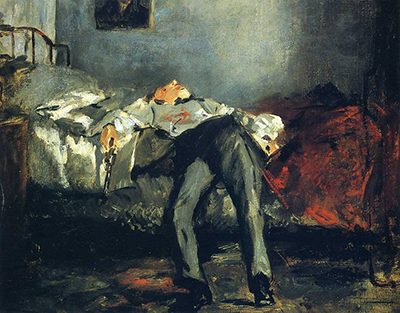Le Suicide was painted between 1877 - 1881, during the Impressionists period and Manet’s final years.
Manet was a massively influential artist during this era, painting subject matter as he saw it in the world around him, showing life in Paris in the 19th century. Other famous artists working during the French Impressionist period include Edgar Degas, Claude Monet and Camille Pissarro. Le Suicide is a small painting created using oil on canvas keeping the typical style of the era with use of bold brush strokes, without too much fine detail, capturing color, light and scenes that are true to life.
Although Manet's oeuvre often consisted of real life images, featuring citizens of Paris going about their daily life, Le Suicide is quite controversial and unusual for the artist as it depicts a macabre image of suicide. Manet did paint other pieces showing death, for example The Execution of Emperor Maximilian and the Dead Toreador, however none were as brutal and realistic as this piece.
Le Suicide presents the viewer with a truly tragic scene showing a man dressed in formal attire, slumped and twisted across a bed, blood showing through his white shirt and across his bed sheets, one hand still clutching the large revolver that was used to commit the gruesome act. The scene that has just unfolded and the detail within the picture, suggest the act had just taken place. We are given very little clues for Le Suicide, leaving the observer to piece together their own ideas, wondering who the protagonist was and what moments led up to his tragic demise. The lack of information surrounding Le Suicide lets the imagination to piece the puzzle together.
Due to the eerily realistic look of Le Suicide, art historians and scholars often speculate as to whether Manet based this piece on a real event that took place in his life, a metaphor for the artist feeling the need to break free from tradition or simply a way for the artist to experiment and practice painting light. Either way, Le Suicide is a controversial, interesting and macabre piece that certainly leaves an observer guessing at the story behind the artwork.




